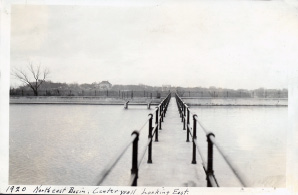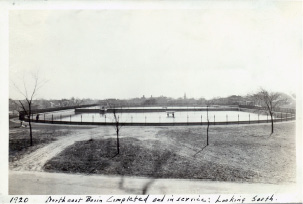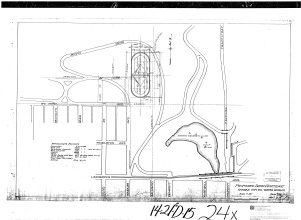By Michael Bushnell
Northeast News
March 14, 2012

Recently, there’s been quite a bit of talk about the possibility of filling in the old reservoir overlooking Cliff Drive with dirt and creating more usable park green space or an area for mountain bikers to test their skills.
Given the historic structure is again the center of attention for redevelopment, we’d like to offer an historic perspective on the original intent and purpose of the long neglected, yet integral piece of Northeast history.
In 1909, Kansas City’s Fire and Water Commission proposed building a large water reservoir atop the bluff overlooking the burgeoning, industrial East Bottoms. The area required a high rate of water for industrial purposes due to the growing number of new factories and manufacturing operations that had located there over the past 10 years. Breweries, ice houses, railroad yards, all in need of large quantities of industrial water.
The plan, however, languished and wasn’t broached again until 1914, when it was mentioned in a parks department report outlining improvements to the parks and boulevard system for the city. Construction of the massive reservoir was finally undertaken in 1919 at roughly the same time the Waldo water tower was being constructed. Upon its completion in 1920, the new Northeast reservoir, along with the older but smaller reservoir in Observation Park near 20th Street and Jarboe, gave the city an industrial water supply of more than 23 million gallons of water to serve its growing manufacturing base in the East and West Bottoms areas.
The new reservoir overlooking the East bottoms measured 590-feet long by roughly 230-feet wide and had a capacity of 16 million gallons of water. The smaller Holly Street reservoir located in Observation Park near 20th and Jarboe was roughly 300 feet long by 150-feet wide and had a capacity of 7.75-million gallons.
Almost immediately after being put into service in 1920, Northeast’s huge basin was beset with problems. Cracks began to develop along the seams of the poured concrete basin under the immense pressure of the collected water.
Due to a growing population and the need for more modern water delivery techniques, Kansas Citians passed an $11 million bond issue to construct a new water works on the north side of the river, complete with water intakes located on the Missouri River. Prior to the completion of the new facility, the city’s water intake was on the Kansas River, downstream from the stockyards and all the slaughterhouses that dumped their spent fluids and waste into the river.
In 1928, the new water treatment facility went online. Shortly thereafter in 1931, the newly constructed Northeast Pumping Station on Nicholson Trafficway in the East Bottoms was put into service, thereby rendering the Northeast reservoir obsolete. Its contents were drained and it’s been a forgotten piece of Northeast history for more than 80 years.
Over the years, a variety of neighborhood-based adaptive re-use ideas have been floated for the old reservoir. Some of those ideas included an amphitheater, a skateboard park and even an extreme sports venue with half pipes, jumps and rails for riders to test their skills. The old reservoir, however, continues to sit neglected and vacant, waiting for an adaptive reuse plan that will best use its cavernous twin bowls and stunning view of the Cliff Drive Scenic Byway.


















